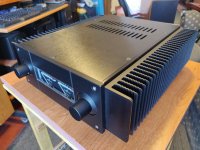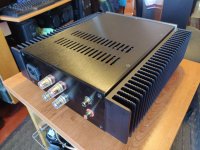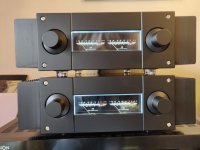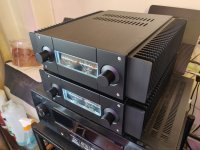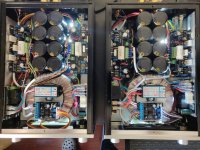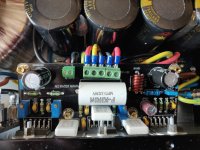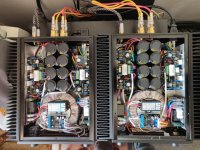Hello world, i decided to share my experience in building my first amplifiers, my goal was to Bi-Amp a pair of speakers SVS ultra towers that requires a quite amount of power, i decided to build 2 amplifiers with 2 modules of 3 x LM3886 chip each, I chosen chipsets LM3886 because they have a good reputation regarding sound quality, and the modules are capable of delivering generous 150 Watts per channel @ 8 ohms.
Some photos attached, please fell free to criticize and comment.
OneDrive
Some photos attached, please fell free to criticize and comment.
OneDrive
Last edited:
Using 2 amplifiers
Greetings dear friend.
I should inform that I’m currently using 2 amplifiers with 2 x 150watts amp modules each, so its one amplifier for each speaker, 2 x 150 Watts for low frequency drivers and 2 x 150 wats for medium and hight frequency drivers, the low frequency has 2 x 8" woofers each speaker, and the high/medium frequency have 2 midrange drivers and 1 tweeter for each speaker and the speakers can handle 250 watts rms each.
If my calculations are some king wrong, please feel free to rectify or comment.
6moons audio reviews: SVS Ultra Tower
Greetings dear friend.
I should inform that I’m currently using 2 amplifiers with 2 x 150watts amp modules each, so its one amplifier for each speaker, 2 x 150 Watts for low frequency drivers and 2 x 150 wats for medium and hight frequency drivers, the low frequency has 2 x 8" woofers each speaker, and the high/medium frequency have 2 midrange drivers and 1 tweeter for each speaker and the speakers can handle 250 watts rms each.
If my calculations are some king wrong, please feel free to rectify or comment.
6moons audio reviews: SVS Ultra Tower
An externally hosted image should be here but it was not working when we last tested it.
3 x LM3886 amplifier modules
Greetings.
For this project i used modules with 3 parallel LM3886 chipsets, This modules have 150 watts each.
The link:
Amazon.com: LM3886 X 3 assembled parallel 150W pure DC mono power amplifier board: Musical Instruments
Greetings.
For this project i used modules with 3 parallel LM3886 chipsets, This modules have 150 watts each.
The link:
Amazon.com: LM3886 X 3 assembled parallel 150W pure DC mono power amplifier board: Musical Instruments
Greetings.
For this project i used modules with 3 parallel LM3886 chipsets, This modules have 150 watts each.
The link:
Amazon.com: LM3886 X 3 assembled parallel 150W pure DC mono power amplifier board: Musical Instruments
Are you actually building it, or you are just purchasing it?
The output power depends on the supply voltage and load resistance. + -35V / 4 ohm
will give about 100 watts (not 150).
I get 125 W into 4 Ω from my Modulus-286, which uses two LM3886es in parallel. This on a ±36 V regulated power supply. You'll get a smidge higher output power from three LM3886es in parallel, so you might push past 130 W, but I doubt you'll get 150 W.
With an unregulated power supply 100 W sounds about right. Maybe slightly more, depending on the amount of reservoir capacitance.
I've written quite a bit about how much power you can expect from an LM3886 and various bridge/parallel combinations of them. You can find my thoughts here: Taming the LM3886: Output Power – Neurochrome
Tom
The output power depends on the supply voltage and load resistance. + -35V / 4 ohm
will give about 100 watts (not 150).
HIEND is not needed for musical instruments
Hello, the manufacturer claims that these modules deliver the 150 Watts at 8 Ohms and 200 Wats at 4 Ohms. i guess i will have to measure it to confirm.
Are you actually building it, or you are just purchasing it?
Greetings, i just bought all the componentes to start building the amplifier, well i didnt make the components, just bought all the modules, chassis, transformers, rectifiers, speaker protection , power delays, vu meters e controllers, etc. i tried to make the amplifier good looking and good sounding as much as possible. i must say it is actually good sounding see pictures on this link : Microsoft OneDrive - Access files anywhere. Create docs with free Office Online.
Hi Tom.
Very nice detailed explanation on the site, those amplifiers from Neurochrome are absolutely a must have, so pity they are expensive.
Each amplifier In my build i used 1 300VA toroidal transformer 2x24V, 2 rectifiers boards with 8 Elna 10000Uf 80v, 2 amplifier modules of 3x LM3886. So each module has a lot of capacitance reserved for the +-36v applied.
Can you please comment my build seeing the photos in this link ? :
Microsoft OneDrive - Access files anywhere. Create docs with free Office Online.
Very nice detailed explanation on the site, those amplifiers from Neurochrome are absolutely a must have, so pity they are expensive.
Each amplifier In my build i used 1 300VA toroidal transformer 2x24V, 2 rectifiers boards with 8 Elna 10000Uf 80v, 2 amplifier modules of 3x LM3886. So each module has a lot of capacitance reserved for the +-36v applied.
Can you please comment my build seeing the photos in this link ? :
Microsoft OneDrive - Access files anywhere. Create docs with free Office Online.
GORGEOUS build ,congratulations.
You certainly spent a lot on case, components, power supply, etc. and it shows, it looks like one of those Hi Fi components shown on Audiophile sites such as 6 moons.
You do show attention to detail.
And it must of course sound GOOD, it´s an LM3886 based amp, after all.
It looks EXPENSIVE.
Only one small detail, I suggest next time you select which pictures represent your job and upload them here, for instant visibility, instead of sending us to a remote storage place where access is not easy.

You certainly spent a lot on case, components, power supply, etc. and it shows, it looks like one of those Hi Fi components shown on Audiophile sites such as 6 moons.
You do show attention to detail.
And it must of course sound GOOD, it´s an LM3886 based amp, after all.
It looks EXPENSIVE.
Only one small detail, I suggest next time you select which pictures represent your job and upload them here, for instant visibility, instead of sending us to a remote storage place where access is not easy.

Some Pictures added
Hi my friend.
Thank you very much for the comment and yes i spent to many hours in building these amplifiers.
At first i wanted to have some good looking vu meters in a nice case then i struggled to find the best position to be able to fit all the components inside, when all was done the amplifiers would become quite hot in 20 minutes of operation, so i had to improvise a way to dissipate more heat, i ordered 4 heat sinks and had glued them with thermal glue, I thought it would look bad but it actually looks kind off cool, now i can operate the amplifiers as long as needed without any heating issues
And yes, this building costed about 1000 Euros in material, if i had the time and effort spent in all of this build it would double for sure.
Have a great day.
Thanks for the advise, some pics:
Hi my friend.
Thank you very much for the comment and yes i spent to many hours in building these amplifiers.
At first i wanted to have some good looking vu meters in a nice case then i struggled to find the best position to be able to fit all the components inside, when all was done the amplifiers would become quite hot in 20 minutes of operation, so i had to improvise a way to dissipate more heat, i ordered 4 heat sinks and had glued them with thermal glue, I thought it would look bad but it actually looks kind off cool, now i can operate the amplifiers as long as needed without any heating issues
And yes, this building costed about 1000 Euros in material, if i had the time and effort spent in all of this build it would double for sure.
Have a great day.
Thanks for the advise, some pics:
Attachments
Last edited:
Hello, the manufacturer claims that these modules deliver the 150 Watts at 8 Ohms and 200 Wats at 4 Ohms. i guess i will have to measure it to confirm.
Almost true. Read link # 8
There is also advice on stabilized nutrition (PSU).
If I will do that, I would route input signal wires away from transformer.
Do not understand why You used two pairs of twisted wires for the input, for one channel it is enough to use single pair. What confused me is picture where you can see input on the amplifier,
In general, very nice.
Do not understand why You used two pairs of twisted wires for the input, for one channel it is enough to use single pair. What confused me is picture where you can see input on the amplifier,
In general, very nice.
Hi my friend.
Thank you very much for the comment and yes i spent to many hours in building these amplifiers.
At first i wanted to have some good looking vu meters in a nice case then i struggled to find the best position to be able to fit all the components inside, when all was done the amplifiers would become quite hot in 20 minutes of operation, so i had to improvise a way to dissipate more heat, i ordered 4 heat sinks and had glued them with thermal glue, I thought it would look bad but it actually looks kind off cool, now i can operate the amplifiers as long as needed without any heating issues
And yes, this building costed about 1000 Euros in material, if i had the time and effort spent in all of this build it would double for sure.
Have a great day.
Thanks for the advise, some pics:
Nice work!
If I will do that, I would route input signal wires away from transformer.
Do not understand why You used two pairs of twisted wires for the input, for one channel it is enough to use single pair. What confused me is picture where you can see input on the amplifier,
In general, very nice.
Hi, one pair was going in to amplifiers and the other pair was outgoing to the vu meter controller, later i decided to remove that route because it was causing some buzzing, now the controller receives the signal directly from the amplifier output.
Attachments
I built 2 x LM3886 amplifiers and was sadly disappointed by their sonic quality, there are far better amplifiers out there.
Try building one and see what you think.
They are OK for anyone building on a budget.
Hi, people usually say that LM3886 is a good chip if built in a well designed board, can you please share your build here ? or at least put some picture of the amplifier board you used ?
Take care.
Hello, the manufacturer claims that these modules deliver the 150 Watts at 8 Ohms and 200 Wats at 4 Ohms. i guess i will have to measure it to confirm.
Even if you ran these at the maximum rated voltage for the LM3886 (±42 V) and was somehow able to get the rail-to-rail output swing, you'd "only" get 110 W into 8 Ω and 220 W into 4 Ω.
Running at the maximum rated voltage is ill-advised to say the least. I would not push past ±36 V. You also drop a few volt (3-3.5 V) across the LM3886, so your output power is likely going to be more like 65 W into 8 Ω and 130 W into 4 Ω. Physics will always trump marketing claims...
Tom
- Status
- This old topic is closed. If you want to reopen this topic, contact a moderator using the "Report Post" button.
- Home
- Amplifiers
- Chip Amps
- Building LM3886 Amplifiers
